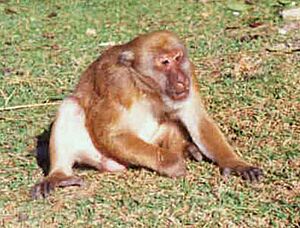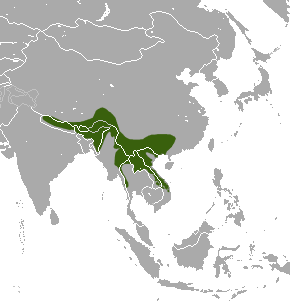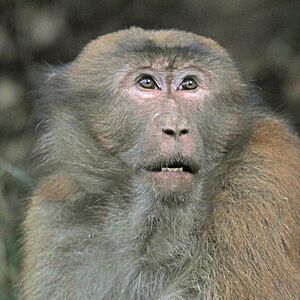Assam macaque facts for kids
Quick facts for kids Assam macaque |
|
|---|---|
 |
|
| Conservation status | |
| Scientific classification | |
| Genus: |
Macaca
|
| Species: |
assamensis
|
 |
|
| Assam macaque range | |
The Assam macaque (Macaca assamensis) is a type of macaque monkey. It belongs to the Old World monkey family. These monkeys live naturally in South and Southeast Asia. Since 2008, experts have listed them as Near Threatened. This means their numbers are dropping. The main reasons for this decline are illegal hunting, their homes being destroyed, and their habitats becoming split up.
Contents
What Does the Assam Macaque Look Like?
Assam macaques have fur that can be yellowish-grey to dark brown. Their facial skin is dark brownish or purplish. They have a dark fringe of hair on their cheeks. This hair points backwards towards their ears. The hair on top of their head is usually parted in the middle.
Their shoulders, head, and arms are often lighter in color. Their back legs and bottom area are more greyish. They have a short, furry tail. An adult macaque's head and body can be about 51 to 73.5 centimeters (20 to 29 inches) long. Their tail is usually 15 to 30 centimeters (6 to 12 inches) long. Adult Assam macaques weigh between 5 and 10 kilograms (11 to 22 pounds).
Where Do Assam Macaques Live?
Assam macaques live in different parts of Asia. In Nepal, you can find them east of the Kali Gandaki river. They live at heights from 200 to 1,800 meters (650 to 5,900 feet). In northeastern India, they live in various types of forests. These include tropical and subtropical evergreen forests. They also live in dry deciduous forests and mountain forests. They can be found up to 4,000 meters (13,000 feet) high.
In Laos and Vietnam, they prefer to live above 500 meters (1,600 feet). They usually live in hilly areas higher than 1,000 meters (3,300 feet). But in wetter eastern regions, they can also be found in lower areas. In forests with limestone rocks, they might also live at lower elevations.
How Do Assam Macaques Live?
Assam macaques are active during the day. This means they are diurnal. They spend time both in trees (arboreal) and on the ground (terrestrial). They eat a variety of foods, so they are omnivorous. Their diet includes fruits, leaves, small bugs, and grains.
In Namdapha National Park in Arunachal Pradesh, India, researchers found 15 groups of these macaques in 2002. There were 209 individual monkeys in total. This means there was about 1 macaque per square kilometer (0.4 square miles). The average group size was about 14 monkeys.
A survey in Nepal's Langtang National Park in 2007 found 213 Assam macaques. They were in 9 groups within a 113 square kilometer (44 square miles) area. The groups had between 13 and 35 monkeys. The average group size was about 24 monkeys. About 31% were adult females and 16% were adult males. The rest were young monkeys of different ages. They liked to eat corn kernels the most. They also ate potato tubers. Sometimes, they would visit fields growing wheat, buckwheat, and millet.
What Challenges Do They Face?
The homes of Assam macaques are facing many challenges. Their forests are being cut down. People are also building things and doing activities that harm their habitat. Sometimes, new types of plants or animals that don't belong there invade their areas. These macaques are also caught by people. They might be caught for sport, for traditional medicine, for food, or to be sold as pets. Also, sometimes they breed with other types of monkeys. This can create mixed populations, which can be a problem for their species.
How Are They Protected?
The Assam macaque (Macaca assamensis) is listed in CITES Appendix II. This means that trading them across borders is controlled. It helps make sure the trade does not threaten their survival. This species is also legally protected in all the countries where it lives. For example, in India, it is listed under Schedule II, part I of the Indian Wildlife Act. This law gives them special protection.




